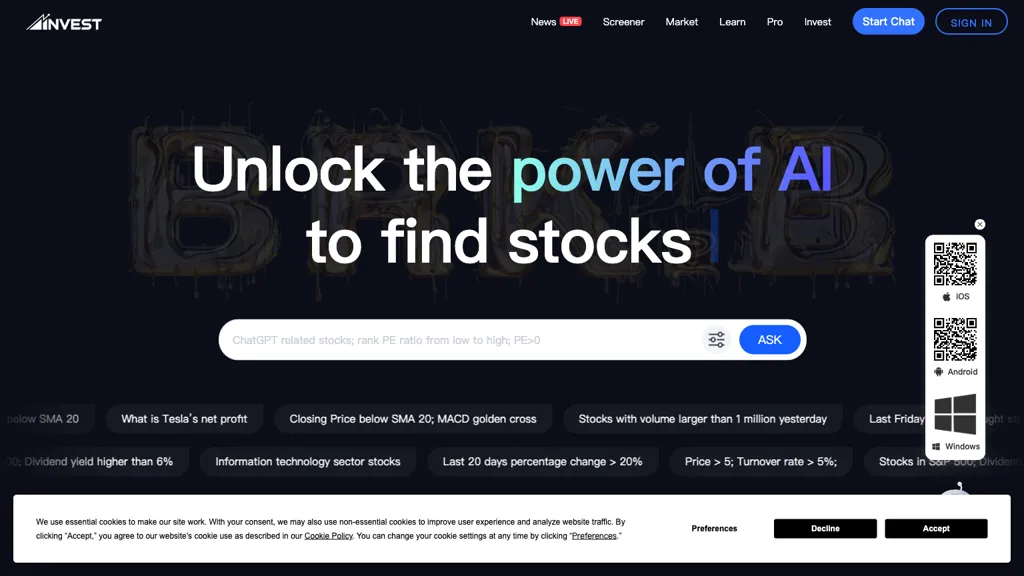20 Recommended Suggestions For Picking AI Stock Trading Sites
Top 10 Tips For Assessing The Market Coverage Of Ai Stock Predicting/Analyzing Trading PlatformsMarket coverage is one of the most important aspects to take into consideration when looking at AI-powered trading platforms. It determines the number of assets and markets are accessible. Platforms that have a wide market coverage permit you to diversify your options and discover global opportunities and can also be adapted to different trading strategies. Here are the top ten ways to determine the market coverage of these platforms.
1. Evaluate Supported Asset Classes
Stocks - Check that the platform is able to provide coverage of major markets for stocks (e.g. NYSE NASDAQ LSE HKEX), and also includes small-caps, mid-caps and large-caps.
ETFs: Make sure the platform supports a wide range of ETFs for diversified exposure to different regions, sectors or even themes.
Futures and options. Check if the platform has derivatives such as futures, options and other leveraged instruments.
The commodities and forex market: Check whether the platform offers the forex pair, precious metals, energy commodities, as well as agricultural commodities.
Cryptocurrencies - Make sure to check whether your application supports major cryptocurrencies like Bitcoin, Ethereum and altcoins.
2. Check for Coverage Area
Global markets. Ensure your platform covers the most important global markets including North America Europe Asia-Pacific and emerging markets.
Regional focus Ensure that the platform has a focus on specific regions or markets that coincide with your trading interests.
Local exchanges - Examine for local or regional exchanges available in relation to your location and your strategy.
3. Think about comparing real-time data to delayed data delayed data
Real-time Data: Make sure that the platform provides real-time data to trade, and to make timely decisions.
The data is delayed. Check if the delayed data is available for free or at a reduced cost, which may suffice for investors who are looking to invest long-term.
Data latency - Verify that the platform reduces delay of feeds that are real-time. This is crucial for high-frequency traders.
4. Review Historical Data Available
The depth of historical data: Verify that the platform has ample data (e.g. more than 10 years old) to test backtesting.
Granularity: Determine whether the historical data include the intraday granularity aswell in weekly, daily and monthly.
Corporate actions: Make sure that the historical data taken into consideration stock splits (if relevant) dividends, stock splits and any other corporate action.
5. Verify Market Depth and Order Book Information
Level 2 data: Ensure that the platform contains Level 2 information for price discovery and for better execution.
Check to see if your platform displays live price spreads.
Volume data: Make sure the platform provides detailed information on volume for analysing market activity and liquidity.
6. Assess how much coverage is available for Indices and Sectors
Major indices: Make sure that the platform has important benchmarking indices, index-based strategies, and other purposes (e.g. S&P 500, NASDAQ 100, FTSE 100).
Sector-specific data : Find out if your platform contains data that is specific to particular sectors (e.g. healthcare, technology energy, healthcare) to allow targeted analysis.
Customized indexes. Check if the platform supports creating and keeping track of custom indices that meet your requirements.
7. Examine the integration of News and Sentiment
News feeds: Make sure that the platform has live feeds of news from credible sources, like Bloomberg and Reuters in the case of market-moving events.
Sentiment Analysis: Check whether the platform has tools for analyzing sentiment that are based on news, social media or other sources of data.
Event-driven trades: Verify the platform's support for trading based on events (e.g. reports on economic data earnings announcements, etc.).
8. Check for Multimarket Trading Abilities
Trading in cross-markets: The platform should permit trading across different asset classes or markets through a single interface for users.
Currency conversion: Check if the platform is compatible with multicurrency accounts, and currency conversions for international trading.
Support for time zones: Check that your platform supports the ability to trade across multiple time zones.
9. Review the coverage of different data sources
Alternative data: Check whether the platform is able to integrate other sources of data (e.g. satellite imagery, web traffic, credit card transactions) for unique insights.
ESG data: Determine whether the platform has environmental as well as social and governance (ESG) information to support socially responsible investment.
Macroeconomic data: Ensure that the platform has macroeconomic indicators to conduct fundamental analysis (e.g. GDP and inflation rates, as well as rate of interest).
10. Review Customer Feedback and Market Reputation
User reviews: Review the feedback of users to assess the platform's market coverage, reliability, and usability.
Find out about the platform's industry standing and reputation. This includes recognition and awards from experts in the field.
Case studies: Look for case studies, testimonials, and other data that demonstrates the effectiveness of the platform on particular market segments or asset types.
Bonus Tips:
Trial period: You may use an demo, trial or free trial to test the market coverage and the data quality.
API access - Check if the API is able to access information on the market by programming.
Customer support: Make sure the platform is able to assist you with any market-related queries or data issues.
These tips will aid you in assessing the market cover of AI stock-predicting/analyzing trading platforms. You will be able choose one that gives you access to data and markets for efficient trading. A broad market coverage can enable you to diversify, explore, and adapt your portfolio in response to market conditions. See the best what do you think on trading ai for site examples including ai for investment, AI stock trading bot free, chatgpt copyright, market ai, incite, ai for investment, best AI stock trading bot free, investing ai, ai trading, ai trading and more.

Top 10 Tips When Assessing The Ai Trading Platforms' Educational Resources
The users must review the educational materials provided by AI trading and stock prediction platforms in order to fully know the platform and the way it operates, as well as to make a well-informed decision when trading. Here are 10 top tips to evaluate the value and quality of these tools.
1. The most complete tutorials and guides
TIP: Look whether there are user guides or tutorials for both beginners and advanced users.
What's the reason? Clear directions help users navigate through the platform and grasp its features.
2. Webinars and Video Demos
Search for webinars, video demonstrations, or live training sessions.
Why? Interactive and visual content makes complex concepts simpler to comprehend.
3. Glossary
TIP: Ensure that the platform provides a glossary or definitions of important financial and AI-related terms.
Why? This will help users, especially those who are new to grasp the terminology employed in the application.
4. Case Studies & Real-World Examples
Tips - See if the AI platform includes cases studies or real-world examples of AI models.
What's the reason? Examples of the capabilities of the platform and its applications are made available to help users understand the platform's capabilities.
5. Interactive Learning Tools
TIP: Look for interactive features such as quizzes and sandboxes.
Why? Interactive tools allows users to try and improve their skills without risking any money.
6. Updated content
Tip: Check whether educational materials have been updated to reflect changes in the marketplace, laws or other new features.
What's the reason? Outdated information could result in confusion and use incorrectly.
7. Community Forums Help, Assistance and Support
Join active forums and support groups where you can discuss your concerns or share your insights.
The reason is peer support, expert advice and assistance from peers can boost learning.
8. Programs of Accreditation and Certification
TIP: Make sure the platform provides certification programs or courses that are accredited.
What is the reason? Recognition of formality will increase trust and inspire learners to pursue their education.
9. Accessibility, User-Friendliness and Usability
Tips: Consider the ease of access and user-friendly the educational materials are (e.g., accessible via mobile devices, PDFs that can be downloaded).
What's the reason? It's because it's easier for users to learn at their own speed.
10. Feedback Mechanism for Educational Content
Check whether the platform allows users to give feedback on the materials.
The reason: Feedback from users is helpful in improving the quality and relevance of the materials.
Bonus Tip: Different Learning Formats
Check that the platform has a variety of learning formats (e.g., audio, video, text) to meet the needs of different learning styles.
When you carefully evaluate each of these factors by carefully evaluating each of these factors, you'll be able to determine if the AI-powered stock prediction and trading system offers an extensive set of tools for education that will aid you to maximize its capabilities and take informed trading decisions. View the best AI stock prediction advice for website advice including ai software stocks, free ai tool for stock market india, chart ai trading, ai trading tool, invest ai, AI stock investing, ai in stock market, ai share trading, best AI stocks, stock predictor and more.
